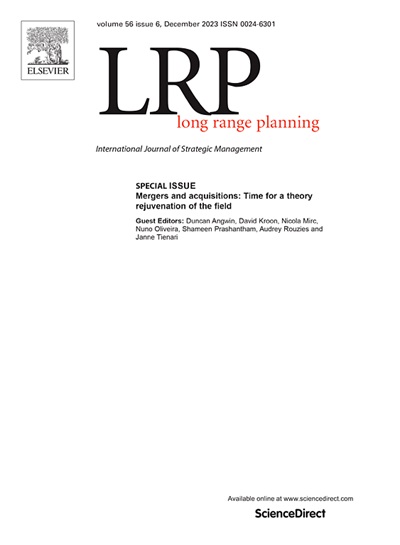Top management teams hierarchical structures: An exploration of multi-level determinants
IF 6.3
2区 管理学
Q1 BUSINESS
引用次数: 0
Abstract
Although the role structure of top management teams (TMT) is a relevant topic in strategic leadership research, the hierarchical structure of TMTs still needs to be explored. In this study, we conduct an exploratory analysis to understand better how TMTs are hierarchically structured and what drives different hierarchical configurations across TMTs. Our empirical analysis of 260 Standard & Poor firms between 2007 and 2018 offers unique insights. Primarily, we discover that even though TMT sizes remained constant between the years of observation, they became less hierarchical in structure, meaning that TMTs became relatively flatter. Moreover, we find that several factors related to CEO characteristics, strategic leadership, corporate governance, and firm and environmental conditions drove the changes in the hierarchical structure of TMTs. These combined empirical insights call for nuanced theoretical explanations of TMT hierarchical structures. We contribute to the TMT literature mainly by highlighting the development of different TMT hierarchical structures and providing new insights into their determinants.
高层管理团队层级结构:多层次决定因素的探索
尽管高层管理团队(TMT)的角色结构是战略领导力研究中的一个相关主题,但高层管理团队的层级结构仍有待探索。在本研究中,我们进行了一项探索性分析,以更好地了解 TMT 的层级结构,以及是什么驱动了不同 TMT 的不同层级配置。我们对 2007 年至 2018 年间 260 家标准普尔公司的实证分析提供了独特的见解。首先,我们发现,尽管 TMT 的规模在观察年份之间保持不变,但它们在结构上的层级化程度却有所降低,这意味着 TMT 变得相对扁平。此外,我们还发现,与首席执行官特征、战略领导力、公司治理以及公司和环境条件相关的几个因素推动了 TMT 层次结构的变化。综合这些经验见解,我们需要对 TMT 层次结构做出细致入微的理论解释。我们对 TMT 文献的贡献主要在于强调了不同 TMT 层次结构的发展,并对其决定因素提出了新的见解。
本文章由计算机程序翻译,如有差异,请以英文原文为准。
求助全文
约1分钟内获得全文
求助全文
来源期刊

Long Range Planning
Multiple-
CiteScore
13.00
自引率
7.10%
发文量
75
期刊介绍:
Long Range Planning (LRP) is an internationally renowned journal specializing in the field of strategic management. Since its establishment in 1968, the journal has consistently published original research, garnering a strong reputation among academics. LRP actively encourages the submission of articles that involve empirical research and theoretical perspectives, including studies that provide critical assessments and analysis of the current state of knowledge in crucial strategic areas. The primary user base of LRP primarily comprises individuals from academic backgrounds, with the journal playing a dual role within this community. Firstly, it serves as a platform for the dissemination of research findings among academic researchers. Secondly, it serves as a channel for the transmission of ideas that can be effectively utilized in educational settings. The articles published in LRP cater to a diverse audience, including practicing managers and students in professional programs. While some articles may focus on practical applications, others may primarily target academic researchers. LRP adopts an inclusive approach to empirical research, accepting studies that draw on various methodologies such as primary survey data, archival data, case studies, and recognized approaches to data collection.
 求助内容:
求助内容: 应助结果提醒方式:
应助结果提醒方式:


